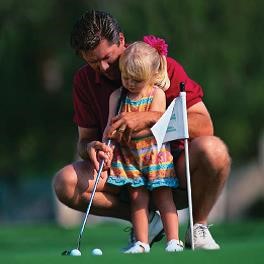
We’ve all heard it said “golf is too hard, too expensive and takes too much time”. We’ve also heard it said that kids are the future of our game. Unfortunately, I still see ads and websites inviting golfers to come play their “challenging course” and wonder how some owners can be so disconnected. We are an aging population and our customers have many opportunities to participate in activities that don’t cost as much, have as many rules or take as long as the game of golf does. Foot Golf and Snag Golf are good ideas but don’t really address the fact that we need to have golf courses that are fun, playable and accessible to golfers of all abilities.
We need to be looking at how to attract those who golf but don’t carry a USGA handicap or even consider themselves “a golfer”. This starts by designing golf holes that have generous landing areas, multiple teeing options and carefully placed hazards.
Studies conducted by the National Golf Course Owner’s Association (NGCOA), the USGA and the Royal Little Family Foundation along with our own observations have taught us that most courses are designed with little consideration for the ability of what we call the “average golfer”. We know that the average male golfer has a swing speed of 90 mph and hits their driver 230 yards while the average women golfer has a swing speed of 65 mph with an average distance of 145 yards. Although factors like wind, soil moisture, ball spin and cutting height can affect these yardages, what is clear is that too many golf courses are simply designed to be too long and too difficult. Then add forced carries, 2.5 inch rough and poorly placed bunkers and golfers quickly become frustrated and disenfranchised.
So what can be done? For starters, we need to design courses that are fair and enjoyable for golfers of all abilities. That starts with “proportional tee design“. Much research has been done on swing speed and golf ball distance so it’s surprising to me that courses are still being built and holes being remodeled with forced carries and forward tees that are simply too challenging for kids, women and seniors.
The following is a chart which represents nearly three decades of tee design research by the National Golf Course Owner’s Association, the USGA and Golf Laboratories on proportional tee placement and the correlation between golfer swing speed and golf ball distance.
| PROPORTIONAL TEE DESIGN | ||
| SWING SPEED |
YARDAGE |
RELATIONSHIP TO OTHER TEES |
| 65 mph-average woman |
3900 – 4100 |
65% |
| 75 mph |
4700 – 4900 |
78% |
| 85 mph |
5600 – 5800 |
93% |
| 90 mph |
6000 – 6200 |
100% *Base tee |
| 95 mph – average man |
6400 – 6600 |
107% |
Most courses, public and private, should be designed for swing speeds between 65-105 mph and yardages between 4,000 yards and 7,000. This means that the forward tees should be roughly 65-75% of the base tee distance. At most regulation courses, this will require at least 5 sets of tee markers.
In addition, tees and bunkers need to be positioned so that golfers using the forward tees are not unfairly penalized and required to hit a disproportionately longer approach shot to the green. More often than not, golfers playing the forward tees are left hitting their approach shot from the same yardage as the more skilled golfer. As a result, a golfer playing from the forward tee might be hitting s 5 wood or 3 wood from 140 yards while the player who is hitting from the back tee is playing an 8 or 9 iron from 150 yards. Ideally, properly designed tees would leave both golfers hitting the same or similar club for their approach shot.
The following chart shows yardages for the “average women” and the “average male” golfer.
| Club Distance Chart | ||
| Club | Average Woman | Average Man |
| Driver | 145 | 230 |
| 3 Metal | 128 | 210 |
| 5 Metal | 118 | 200 |
| 7 Metal/3 Hybrid | 110 | 191 |
| 9 Metal/5 Hybrid | 102 | 170 |
| 5 iron | 94 | 163 |
| 6 iron | 88 | 151 |
| 7 iron | 82 | 143 |
| 8 iron | 76 | 132 |
| 9 iron | 72 | 120 |
| PW | 54 | 110 |
**Note: These distances are based on data from a variety of sources including Golf Laboratories, the National Golf Course Owners Association and the USGA.
Many courses have now started using “combination tees”. This is a simple and inexpensive way to add more teeing options to make golf more enjoyable for a wider range of golfers.
Lastly, I often suggest to my clients that they abandon the traditional red, white and blue tee marker system and instead utilize a marking system that requires the golfer to select their tee based on the yardage rather than the color of the tee. I’ve never heard anybody complain that a golf course was too easy or too profitable.
Kevin Norby is the owner and senior designer at Herfort Norby Golf Course Architects. For more information, you may contact Kevin at (952)361-0644 or via email at knorby@HerfortNorbyGolf.com. You may also visit Herfort Norby’s website at www.herfortnorby.com.

Alex Van Alen - FlingGolf
Thanks Kevin and JJ. This is anecdotal, but in our FlingGolf sales to courses across the country, it seems there are thousands of courses that are in the 5800 to 6300 yard range (and many nine holers half that distance), which is perfect for FlingGolf as it is more of a strategic shot shaping sport than pure distance. That is where the fun of the sport comes in – spin and accuracy to nail the green more often from 150 yards out. While FlingGolf can be played on any course, we are happy to be filling tee times on shorter courses whose use has declined because of the much longer distances due to ball and equipment improvements in golf. (FlingGolf is played just as well with a range ball as it is a ProV1.) Our partnership with the National Golf Course Owners Association is helping us recognize and reach those courses that fall in the FlingGolf sweetspot – ie the 5800-6300 yards.